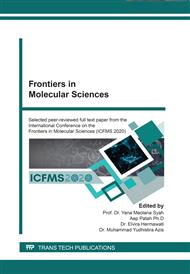[1]
C.A. Martínez-Huitle, S. Ferro, Electrochemical oxidation of organic pollutants for the wastewater treatment: direct and indirect processes, Chem Soc Rev. 35 (2006) 1324–1340.
DOI: 10.1039/b517632h
Google Scholar
[2]
V. Homem, A. Alves, L. Santos, Amoxicillin degradation at ppb levels by Fenton's oxidation using design of experiments, Sci. Total Environ. 408 (2010) 6272–6280.
DOI: 10.1016/j.scitotenv.2010.08.058
Google Scholar
[3]
A. Ledezma Estrada, Y.-Y. Li, A. Wang, Biodegradability enhancement of wastewater containing cefalexin by means of the electro-Fenton oxidation process, J. Hazard. Mater. 227–228 (2012) 41–48.
DOI: 10.1016/j.jhazmat.2012.04.079
Google Scholar
[4]
V. Homem, L. Santos, Degradation and removal methods of antibiotics from aqueous matrices – A review, J. Environ. Manage. 92 (2011) 2304–2347.
DOI: 10.1016/j.jenvman.2011.05.023
Google Scholar
[5]
C. Comninellis, Electrocatalysis in the electrochemical conversion/combustion of organic pollutants for waste water treatment, Electrochimica Acta. 39 (1994) 1857–1862.
DOI: 10.1016/0013-4686(94)85175-1
Google Scholar
[6]
Institute of Chemistry, Jan Kochanowski University, Swietokrzyska St. 15G, PL-25406 Kielce, Poland, M. Jakubczyk, Electrochemical Behavior of Butylated Hydroxyanisole and Butylated Hydroxytoluene in Acetic Acid Solutions and their Voltammetric Determination in Pharmaceutical Preparations, Int. J. Electrochem. Sci. (2018) 4251–4266.
DOI: 10.20964/2018.05.76
Google Scholar
[7]
L. Szabó, T. Tóth, E. Takács, L. Wojnárovits, One-Electron Reduction of Penicillins in Relation to the Oxidative Stress Phenomenon, Int. J. Mol. Sci. 16 (2015) 29673–29681.
DOI: 10.3390/ijms161226130
Google Scholar
[8]
E.S. Elmolla, M. Chaudhuri, Degradation of amoxicillin, ampicillin and cloxacillin antibiotics in aqueous solution by the UV/ZnO photocatalytic process, J. Hazard. Mater. 173 (2010) 445–449.
DOI: 10.1016/j.jhazmat.2009.08.104
Google Scholar
[9]
H. Herlina, M.A. Zulfikar, B. Buchari, Cyclic voltammetry in electrochemical oxidation of amoxicillin with Co(III) as mediator in acidic medium using Pt, Pt/Co and Pt/Co(OH) 2 electrodes, MATEC Web Conf. 197 (2018) 05004.
DOI: 10.1051/matecconf/201819705004
Google Scholar
[10]
G. Karim-Nezhad, M. Hasanzadeh, L. Saghatforoush, N. Shadjou, B. Khalilzadeh, S. Ershad, Electro-oxidation of ascorbic acid catalyzed on cobalt hydroxide-modified glassy carbon electrode, J. Serbian Chem. Soc. 74 (2009) 581–593.
DOI: 10.2298/jsc0905581k
Google Scholar
[11]
B. Rezaei, S. Damiri, Electrochemistry and Adsorptive Stripping Voltammetric Determination of Amoxicillin on a Multiwalled Carbon Nanotubes Modified Glassy Carbon Electrode, Electroanalysis. 21 (2009) 1577–1586.
DOI: 10.1002/elan.200804571
Google Scholar
[12]
J. Wang, Analytical Electrochemistry (Second Edition), Wiley-VCH, Erscheinungsort nicht ermittelbar, 2000. http://onlinelibrary.wiley.com/book/10.1002/0471228230 (accessed February 19, 2020).
Google Scholar
[13]
D. Cairns, Essentials of pharmaceutical chemistry, 3. ed, Pharmaceutical Press, London, (2008).
Google Scholar
[14]
M.M. Shoukry, Potentiometric studies of binary and ternary complexes of amoxycillin, Talanta. 39 (1992) 1625–1628.
DOI: 10.1016/0039-9140(92)80194-i
Google Scholar


